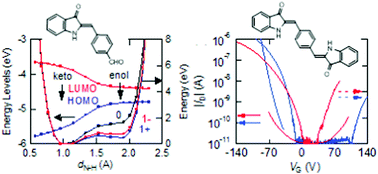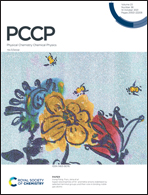Charge injected proton transfer in indigo derivatives†
Abstract
In analogy with excited-state proton transfer, proton transfer is significantly facilitated in cationic and anionic molecules of indigo derivatives generated in field-effect transistors. We have prepared extended and truncated indigo derivatives and investigated their ambipolar transistor properties. Since the proton transfer reduces the energy gap from 2.2 to 0.4 eV, the proton transferred states are stabilized in the charge injected cationic and anionic states; the energy increase is as small as 0.5 eV, which is half of that in the neutral state. The intermolecular proton transfer enlarges the equilibrium N–H distance typically by 0.03 Å, and improves the donor and acceptor abilities by 0.2–0.4 eV, though the reorganization energy is practically unchanged. In addition, the transfer integrals along the hydrogen bonds are as large as one third of the columnar transfers, to facilitate the two-dimensional carrier conduction. The influence of proton transfer is most significant in indigo and truncated indigo derivatives, though isoindigo and quinacridone exhibit similar properties. Accordingly, indigo derivatives show much better donor and acceptor abilities than those expected from isolated molecules.



 Please wait while we load your content...
Please wait while we load your content...